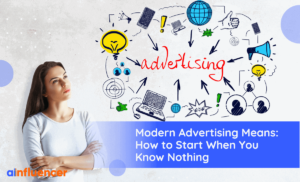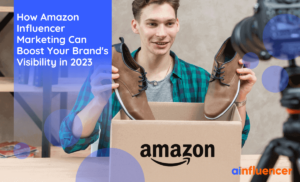Influencer marketing is a rapidly evolving space that has taken the marketing world by storm. Influencer marketing is not just a buzzword but a legitimate marketing strategy that can help your brand reach its full potential.
In simple words, it is the art of partnering with people who have a significant online following to promote your brand or product.
Influencer marketing has come a long way from its early days of Instagram sponsored posts. Today, influencers can be found across a wide range of platforms, from TikTok to YouTube, and even on niche blogs and podcasts, says Mark Valderrama, CEO & Founder of Aquarium Store Depot. And the benefits of working with influencers can be huge, from increased brand awareness and reach to improved credibility and trust with your target audience.
But, like any marketing strategy, influencer marketing requires careful planning, execution, and evaluation. And that’s what we’re here to help you with.
In this guide, we’ll show you how to unlock the full potential of influencer marketing and master the strategy.
We’ll cover everything from finding the right influencers for your brand, creating a killer influencer marketing strategy, building relationships with influencers, measuring success and ROI, and best practices to follow.
We’ll also provide real-life examples and practical advice to help you navigate the world of influencer marketing like a pro.
Let’s get started.
Finding the Right Influencers
It all starts with finding the right influencers. It’s one of the biggest challenges in the influencer marketing industry. But don’t worry, by using an influencer marketplace such as Ainfluencer, you can search for your desired influencers, invite them to collab with you, and run influencer marketing campaigns.
Here we’ve got some tips and tricks to help you find influencers that are perfect for your brand.
Define Your Target Audience: “Before you start searching for influencers, it’s crucial to define your target audience. This allows you to identify the right influencers who have a strong following within your desired demographic, and create content that speaks directly to their interests and needs.”, says Sumeer Kaur, founder of Lashkaraa.com. Answer these questions: Who are you trying to reach? What are their interests, demographics, and behaviors? Simply put, the type of audience you have and the type of influencers you should reach out to.
Research Your Industry: Research your industry to identify the influencers who are already talking about your products or services. Use tools like BuzzSumo or Followerwonk to find influencers in your industry or niche.
Analyze Their Audience and Engagement: Not all influencers are equal. Analyze their audience and engagement to ensure that they are a good fit for your brand. Look for influencers who have high engagement rates, authentic audiences, and a strong connection with their followers.
Consider Micro Influencers: Micro influencers are influencers with smaller followings, typically between 1,000 to 100,000 followers. While they may not have the massive reach of macro influencers, micro influencers often have higher engagement rates and are more affordable to work with.
Look Beyond Follower Count: “While follower count is an important metric to consider, it’s not the only one. Look beyond follower count to consider other factors such as audience demographics, location, and interests.”, says Tom Miller, Director of Marketing at FitnessVolt. Because ideally, the influencer’s audience and your audience should be the same — so when they promote your product, their followers can easily resonate with the message and buy.
A great example of a brand finding the right influencer is Glossier’s partnership with YouTuber Jackie Aina. Glossier, a beauty brand, partnered with Jackie Aina, a beauty influencer who had been critical of the lack of diversity in the beauty industry. The partnership allowed Glossier to tap into Jackie’s engaged audience while also addressing concerns about inclusivity and diversity in the industry.
“Finding the right influencers is a crucial first step in any successful influencer marketing strategy,” says Brad Anderson, founder of FRUITION. “Take the time to research and analyze potential influencers, so you can ensure that your partnership will be a success.”
Creating an Influencer Marketing Strategy
Now that you’ve found the right influencers for your brand, it’s time to create a killer influencer marketing strategy. Here are some tips to help you get started:
- Define Your Goals: What are you trying to achieve with your influencer marketing campaign? Are you looking to increase brand awareness, drive sales, or improve brand credibility? Defining your goals upfront will help you measure success and ensure that your campaign aligns with your overall marketing strategy.
- Set a Budget: Influencer marketing can be expensive, so it’s important to set a budget upfront. Consider the cost of working with influencers, as well as any other associated costs, such as content creation or platform fees.
- Define Your Message: What do you want your influencers to say about your brand or product? It’s important to define your message and communicate it clearly to your influencers. Make sure your message is authentic and aligns with your brand values.
- Create a Content Strategy: Partner with your influencers to create a content strategy that aligns with your message and goals. Consider the type of content that will resonate with your target audience and the platforms where you want to reach them.
- Start Reaching Out: Finally, start reaching out to relevant influencers. You can approach them via messages, emails, or letters. Keep it professional, and recognize them for their efforts and content.
- Measure Success and ROI: Measuring success and ROI is crucial for any marketing campaign, and influencer marketing is no exception. Define the metrics you’ll use to measure success, such as reach, engagement, or sales, and track your progress throughout the campaign.
A great example of a brand creating an effective influencer marketing strategy is Daniel Wellington’s partnership with multiple influencers. The watch brand partnered with influencers to create content on Instagram that showcased the watches in a lifestyle context. The campaign was so successful that Daniel Wellington’s revenue increased from $15 million in 2014 to over $220 million in 2018.
Gene Fitzgerald, Head of Marketing at BOS, says, “Creating a successful influencer marketing strategy is no easy feat, but it sure works like a charm. Define your goals, message, and content strategy upfront. Then keep on tracking to ensure greater ROIs.”
Building Relationships with Influencers
Building strong relationships with your influencers is key to the success of your influencer marketing campaign. Because, at the end of the day, influencers are real people, not business tools. Deepen your relationship with them on a personal level so they feel valued and pour their heart out while promoting your brand.
Here are some tips to help you establish and maintain positive relationships with your influencers:
- Treat Them Like Partners: Influencers are more than just paid endorsers. They are partners in your marketing campaign, and treating them as such can help establish a positive and collaborative relationship.
- Communicate Clearly and Frequently: Effective communication is essential to any successful partnership. Hamza G., the digital marketing expert at Outreaching.io, says, “Clear communication between brands and influencers is crucial to ensure that the campaign objectives and expectations are met.” Make sure you communicate your expectations clearly and keep your influencers informed throughout the campaign.
- Provide Creative Freedom: Influencers are creative individuals, and giving them the freedom to create content that aligns with your brand can lead to more authentic and engaging content.
- Compensate Them Fairly: Compensation is a key consideration when working with influencers. Make sure you compensate them fairly for their time and effort and consider non-monetary incentives such as product samples or exclusive experiences.
- Follow-Up and Show Appreciation: After the campaign is over, make sure you follow up with your influencers and show your appreciation for their contributions. This can help establish a long-term relationship and pave the way for future collaborations.
One brand that has built strong relationships with influencers is Glossier. The beauty brand often collaborates with micro influencers and encourages them to share their own stories and experiences with Glossier products. Glossier also hosts events and meetups for its influencers, creating a sense of community and fostering long-term relationships.
On building relationships with influencers, Jonathan Faccone, managing member and founder of Halo Homebuyers, shares, “Building strong relationships with influencers takes time and effort, but the benefits can be significant. By treating your influencers like partners, communicating effectively, and compensating them fairly, you can establish positive and long-lasting relationships that benefit your brand and your influencers.”
Measuring Success and ROI
Measuring the success of your influencer marketing campaign is crucial to determining its effectiveness and ROI. Here are some key metrics to consider when measuring the success of your campaign:
- Engagement Metrics: One of the most important metrics to track is engagement. This includes likes, comments, shares, and other forms of engagement on social media platforms. These metrics can provide insight into the level of interest and engagement your content is generating among your target audience.
- Conversion Metrics: Another key metric to track is conversions, which include clicks, website traffic, and sales. By tracking these metrics, you can determine whether your influencer marketing campaign is generating the desired results and driving meaningful actions from your target audience.
- Brand Awareness Metrics: Tracking brand awareness metrics can help you determine the effectiveness of your influencer marketing campaign. This includes metrics such as reach, impressions, and brand mentions, which can provide insight into how well your brand is resonating with your target audience.
- ROI: Ultimately, the success of your influencer marketing campaign will depend on its ROI. This can be determined by comparing the costs of the campaign to the value generated, such as increased sales, website traffic, or brand awareness.
“Measuring the success and ROI of your influencer marketing campaign can be challenging because there’s no direct dashboard to track metrics,” says Kenny Kline, President and financial lead at Barbend. “The key things, however, to look at are a qualitative measures of conversions, views, clicks, and brand awareness. Based on that, calculate the ROI to determine whether your campaign is generating the desired results and adjust your strategy accordingly.”
Best Practices for Influencer Marketing
To maximize the effectiveness of your influencer marketing campaign, here are some best practices to keep in mind:
- Choose the right influencers: We’ve talked about it earlier in the post, yet I’m mentioning this again — that’s because the right influencer will scale your game. The wrong one can break. Selecting the right influencers for your campaign is critical to its success. Jeoffrey Murray, digital marketing expert at Solar Panel Installation, shares, “Look for influencers whose audience aligns with your target audience and who have a strong track record of engagement and authenticity.”
- Be clear about your goals and expectations: Before launching your campaign, be clear about your goals and what you expect from your influencers. This includes the type of content you want them to create, the messaging and tone, and any specific calls to action you want them to include.
- Disclose sponsorships: Disclose any sponsorships or partnerships between your brand and the influencer. This not only ensures compliance with advertising regulations but also promotes transparency and authenticity amongst your audience. “Transparency is key in influencer marketing. It builds trust with your audience and strengthens the relationship between influencers, brands, and consumers.”, says Jake Smith, founder of Personalised Number Plates.
- Be authentic: Authenticity is key to building trust and establishing a strong connection with your audience. Ensure that your influencers are a natural fit for your brand and that their values and messaging align with yours.
- Stay engaged: Building a successful influencer partnership is not a one-and-done deal. Stay engaged with your influencers beyond the initial collaboration and maintain regular communication to keep the relationship strong.
- Stay up-to-date on regulations: Influencer marketing is a rapidly evolving field, and regulations around sponsored content and disclosure are constantly changing. Stay up-to-date on the latest guidelines to ensure that your campaigns are compliant and transparent.
“Influencer marketing is not just about finding the biggest following, but about finding the right fit,” says Alison Lancaster, CEO of Pressat.co.uk. “The best practice is to work with influencers whose values align with your brand, and who have an engaged and loyal audience that trusts their recommendations.”
Conclusion
Influencer marketing is a powerful strategy that can help your brand reach new audiences and build authentic connections with consumers. By finding the right influencers, creating a solid strategy, building strong relationships, measuring success and ROI, and following best practices, you can unlock the potential of influencer marketing and drive meaningful results for your brand.
Anthony Milia, author and award-winning digital marketer at Milia Marketing, concludes, “In today’s digital age, consumers are looking for more personalized and relatable experiences with brands, and influencer marketing can help you achieve just that. By partnering with influencers who resonate with your target audience and creating authentic content, you can build trust and establish a loyal following.”
Remember, influencer marketing is not a one-size-fits-all strategy, and it requires careful planning, execution, and monitoring to ensure success. But with the right approach, it can be a powerful tool in your marketing toolkit.
So, if you haven’t already, consider incorporating influencer marketing into your marketing strategy and start reaping the benefits it can offer.









